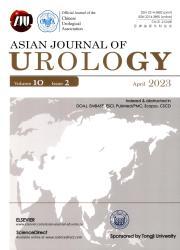输尿管镜后激光碎石致狭窄的机器人颊输尿管成形术的十年经验——这应该成为新的标准吗?
IF 2.4
3区 医学
Q2 UROLOGY & NEPHROLOGY
引用次数: 0
摘要
目的介绍激光碎石术后输尿管狭窄机器人颊输尿管成形术的手术技术及效果。方法回顾性研究于2012年10月至2022年10月在印度金奈阿波罗医院泌尿外科进行。手术指征包括肾积水加重、肾功能下降、尿路感染复发并梗阻。除了自由暴露狭窄外,我们强调使用吲哚菁绿来评估血管性和移植物对腰肌裸露区域的缝合,以增加移植物的血管性。结果15例患者中,输尿管盂连接处狭窄8例(53%),输尿管近端狭窄5例(33%),输尿管中端狭窄2例(13%)。值得注意的是,15例患者中有8例(53%)曾有过不成功的双j型支架置入。中位狭窄长度为3.5(范围:2.0-5.0)cm,平均手术时间为167(范围:126-214)min,估计失血量为60(范围:40-100)mL。中位随访12(范围:4-32)个月后,15例患者中有13例(87%)在随访功能扫描中表现出显著改善。结论机器人输尿管颊部成形术是治疗激光致输尿管狭窄的有效方法,远期疗效好,并发症少。结果是可比性的,与之前失败的支架置入无关。本文章由计算机程序翻译,如有差异,请以英文原文为准。
A decade's experience of robotic buccal ureteroplasty for post-ureteroscopic laser lithotripsy-induced strictures—Should this be the new standard?
Objective
To present the surgical technique of robotic buccal ureteroplasty for strictures after laser lithotripsy and its outcomes.
Methods
This was a retrospective study conducted at the Department of Urology, Apollo Hospitals, Chennai, India from October 2012 to October 2022. Indications for surgery included worsening hydronephrosis, declining renal function, and recurrent urinary tract infections with obstruction. Apart from liberal exposure of the stricture, we stress upon use of indocyanine green to assess vascularity and quilting of the graft to bare area of the psoas muscle to increase graft vascularity.
Results
Among the 15 patients, ureteropelvic junction strictures were observed in eight (53%), while five (33%) had proximal ureteric strictures, and two (13%) had mid-ureteral strictures. Notably, eight of the 15 patients (53%) had previous unsuccessful double-J stenting. The median stricture length was 3.5 (range: 2.0–5.0) cm, with a mean operative time of 167 (range: 126–214) min and estimated blood loss of 60 (range: 40–100) mL. After a median follow-up of 12 (range: 4–32) months, 13 out of the 15 patients (87%) showed significant improvement in their follow-up functional scans.
Conclusion
Robotic buccal ureteroplasty is a very effective technique for the management of laser-induced ureteral strictures with good long-term results and minimal morbidity. The results are comparable irrespective of previous failed stenting.
求助全文
通过发布文献求助,成功后即可免费获取论文全文。
去求助
来源期刊

Asian Journal of Urology
UROLOGY & NEPHROLOGY-
CiteScore
4.00
自引率
3.80%
发文量
100
审稿时长
4 weeks
期刊介绍:
Asian Journal of Urology (AJUR), launched in October 2014, is an international peer-reviewed Open Access journal jointly founded by Shanghai Association for Science and Technology (SAST) and Second Military Medical University (SMMU). AJUR aims to build a communication platform for international researchers to effectively share scholarly achievements. It focuses on all specialties of urology both scientifically and clinically, with article types widely covering editorials, opinions, perspectives, reviews and mini-reviews, original articles, cases reports, rapid communications, and letters, etc. Fields of particular interest to the journal including, but not limited to: • Surgical oncology • Endourology • Calculi • Female urology • Erectile dysfunction • Infertility • Pediatric urology • Renal transplantation • Reconstructive surgery • Radiology • Pathology • Neurourology.
 求助内容:
求助内容: 应助结果提醒方式:
应助结果提醒方式:


